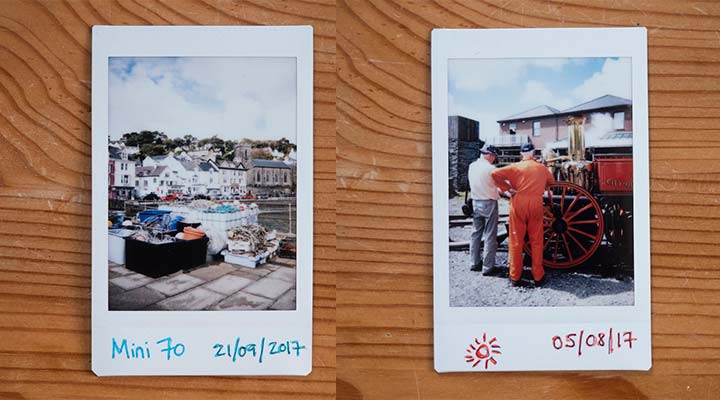
Polaroid Tips for Storing Instant Film
May 26, 2025 / Alyssa Duranty
Photography student Brian Garbrecht has been storing instant film since it initially left stores in the early 2000s, and he learned a lot of Polaroid tips to keep his film functional. Thankfully for him and other Polaroid enthusiasts, the retro media medium of instant photography is making its way back into pop culture.
“My parents got me an instant camera in high school in 2002, and they started buying me film every time they went into the store,” he said. “It was right before they stopped (initially) making instant film, so they bought me as many packs they could before they ran out.”
Instant film faded out when digital photos became mainstream, so why the resurgence?
“I think people are appreciating one-of-a-kind items, like a Polaroid and things you can hold in your hand – like books and vinyl records,” Garbrecht said. “The photograph represents the one-of-a-kind moment when it was taken.”
Since instant film is full of sensitive chemicals that affect the picture’s ultimate quality, it’s important to store it properly.
“Initially, I didn’t know how to take care of them,” Garbrecht said. “I just kept them on a shelf. But more recently, about three years ago, I got more serious about photography I learned how to take care of instant film.”
If you’re also ready to get serious about instant photography, keep reading for Garbrecht’s Polaroid tips. We also included more advice from two more instant film hobbyists, including cofounder of the Instant Film Society, to help you store your instant film for future fantastic photos.
Store Instant Film in Refrigerators
One of the first rules of film photography is to keep your film in a cool environment, said Heather Broster of the Instant Camera Blog.
“The benefit is that it slows down the chemical ageing process and keeps it fresh,” she added.
However, do not freeze your instant film as it will crack the chemicals inside!
“Extreme temperatures need to be avoided, because the photographic and physical properties of the film can be adversely affected,” Broster said.
Garbrecht bought two extra refrigerators to store his Polaroid film and other types of film at home.
“You want an environment that’s not too dry and not too wet,” he said. “Some people keep them in basements, and that’s cool enough.”
Garbrecht is a member of the Instant Film Society based in the Dallas area. Justin Goode, cofounder of the society, stores his filmin the bottom of his fridge, where it’s typically between 55 and 60 degrees Fahrenheit.
“My wife was cursing at me, because my film was taking up a third of our fridge,” he laughed. “It’s my soul food!”
Don’t forget to take the film out 24 hours before your upcoming photoshoot, so it has time to return to room temperature, our experts recommended.
Keep Instant Film and Cameras Away From Sunlight
Sunlight and heat will not only warp photos, but it will change how your Polaroid pictures look after the quick processing.
“All types of film are very sensitive to heat and humidity, and (instant) film is no exception,” said Broster. “Both can affect the photosensitive layers or the additional chemicals responsible for the development process, causing unwanted color changes for example.”
Goode said overheated instant film will turn pictures orange and red.
“I used to put an ice pack inside my camera bag to keep the film cool,” he added.
Keep Polaroids and other instant cameras away from sunny spots.
“The foam on the inside will start to break down and get crusty, and you’ll get a light leak,” said Goode. “The rubber on the side can crack, so it’s important to keep your cameras at a regulated temperature and out of direct sunlight.”
Use the film in an instant camera as quickly as possible.
“The longer you leave it inside the camera, the higher the possibility of color changes, light leaks and so on,” said Broster.
Store Processed Polaroids Upright
While it’s important to protect instant film before it contains a photograph, it’s as vital to store processed pictures in ideal conditions to keep them from changing color or warping.
“Finished photos should also be protected, ideally in an album or box stored in a dark, dry place that isn’t exposed to extreme heat or harmful gases,” said Broster.
And don’t just throw the rare photos in a box if you want to cherish them for years to come.
“If you’re putting the photographs in a shoebox, store them upright and don’t stack a bunch of sheets of film on top of each other, because they will warp and take time to become flat again,” said Goode.
If you buy older packs of Polaroid film from a fellow collector, make sure the old Polaroid film was in ideal condition before storage, Garbrecht said.
“When the film starts to degrade, it can cause the chemical pods to dry out,” he said. “So you should shake the pack of film next to your ear. If you can hear crystals moving around, it’s not a good pack because the pods are dry.”
Photos courtesy of Justin Goode of the Instant Film Society and Heather Broster (in order of appearance).







